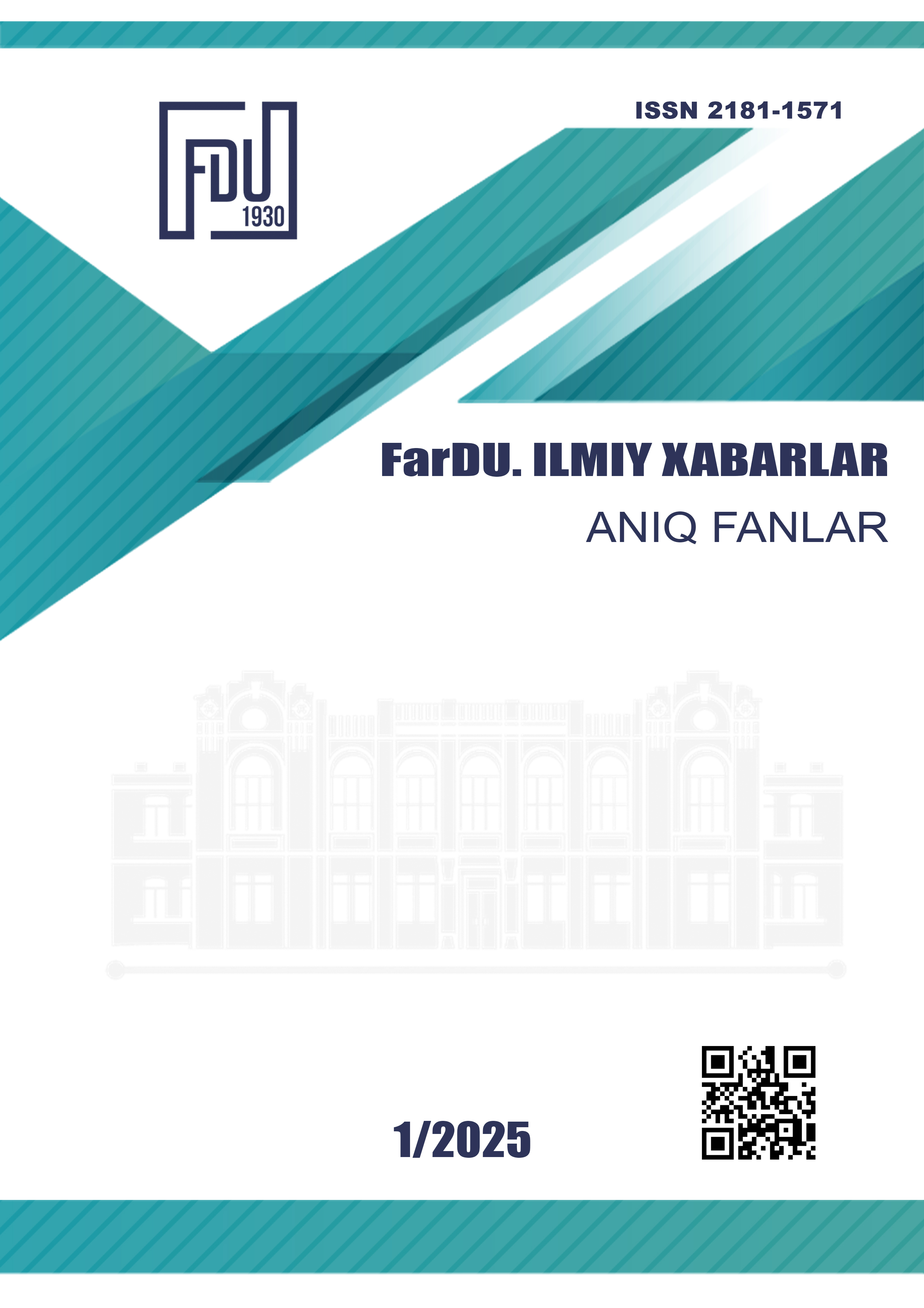INVESTIGATION OF THE ELEMENTAL COMPOSITION OF SOME WIDELY DISTRIBUTED HELIOTROPIUM SPECIES IN UZBEKISTAN
Keywords:
Heliotropium lasiocarpum, Heliotropium dasycarpum, family Boraginaceae, elemental composition, ISP OES method.Abstract
The elemental composition of the roots and aerial parts of Heliotropium lasiocarpum and Heliotropium dasycarpum, belonging to the Heliotropium family and growing in the Fergana Valley of Uzbekistan, was studied using the ICP-OES method. A total of 21 elements were identified and classified into macroelements, microelements, essential, and heavy metals for analysis. Among the detected elements, Ca, K, and Mg were found in relatively high concentrations (above 1000 mg/kg), while Na, Fe, and Zn were present in significant amounts (50–1000 mg/kg). The Mn content was moderate (10–100 mg/kg), whereas Cr, Ni, V, Li, and Cu were found in low concentrations (1–10 mg/kg). The levels of Se, As, and Co were very low (1–5 mg/kg), and Ag, Be, Cd, and Hg were not detected. The study revealed that macroelements such as Ca, K, and Na, as well as the microelement Fe, predominated in both the underground and aerial parts of the plants. The detected concentrations of heavy metal salts complied with the requirements set by the XIII edition of the State Pharmacopoeia of the Russian Federation and the WHO standards.
References
Диана, Н., Фортер, Х., Хильгер, Х.Х. (2002-02-01). «Систематический анализ Heliotropium, Tournefortia и родственных таксонов семейства Heliotropiaceae (Boraginales) на основе последовательностей ITS1 и морфологических данных». //Американский журнал ботаники.89 (2): 287–295.
Heliotropium. The Plant List. http: //www.theplantlist.org.1.1.browse. A.Boraginaceae. Heliotropium.
https: //www.asienda.ru.plants.geliotrop.geliotrop-evropejskij.
Какар Ф., Акбарян З., Лесли Т., Лайс М., Уотсон Д., Ван Ханс Э., Фахим О.М., Мофле Д. // Журнал токсикологии. 2010: 1–7. DOI:10.1155/2010/313280.
Chuanhui Ma, Yang Liu, Lin Zhu, Hong Ji, Xun Song. Determination and regulation of hepatotoxic pyrrolizidine alkaloids in food: A critical review of recent research (англ.) // Food and Chemical Toxicology.2018-09-01. Vol.119. P. 50–60. ISSN 0278-6915.—doi:10.1016/j.fct.2018.05.037.
Юнусов С.Ю. // Справочник «Алкалоиды». 1981. С. 312-313.
Введенский А.И. // Флора Узбекистана. Том 5. Ташкент: изд-во АН УзССР. 1961. С. 668.
Г.П. Сидякин, С.Ю. Юнусов. //Доклады АН УзССР. 1950. 1. С. 3.
Оберлис Д., Харланд Б., Скальный А. Биологическая роль макро- и микроэлементов у человека и животных. Оренбург, 2018. 658 с.
Полянская И.С. Новая классификация биоэлементов в биоэлементологии // Молочно-хозяйственный вестник. 2014. №1. С. 34–42.
ОФС.1.1.0013.15. Статистическая обработка результатов химического эксперимента // Государственная фармакопея Российской Федерации. XIV изд. М., 2018. Т. 1. С. 289–318.
ОФС 1.5.3.0009.15. Определение содержания тяжелых металлов и мышьяка в лекарственном растительном сырье и лекарственных растительных препаратах // Государственная фармакопея Российской Федерации. XIII изд. М., 2015. Т. 2. С. 421–433.
World Health Organization et all. National policy on traditional medicine and regulation of herbal medicines: Report of a WHO global survey. Geneva, 2005. 168 p.
Коломийцева М.Г., Габович Р.Д. //Микроэлементы в медицине. М. 1971.
Лысиков Ю.А. Макро- и микроэлементы в организме человека: функции, дефицит/профицит //Журнал “Справочник специалиста”. 2008. № 20. C. 262.
Tonelli M, Wiebe N., Hemmelgarn B., et al., Alberta Kidney Disease Network. Trace elements in hemodialysis patients: a systematic review and meta-analysis. //BMC Med. 2009 May 19; 7:25. doi: 10.1186/1741-7015-7-25.
Downloads
Published
Issue
Section
License
Copyright (c) 2025 Scientific journal of the Fergana State University

This work is licensed under a Creative Commons Attribution-NonCommercial-NoDerivatives 4.0 International License.
How to Cite
Most read articles by the same author(s)
- , , , , SYNTHESIS OF ACETYLENE ALCOHOLS BASED ON ENANTIOSELECTIVE ETHYNYLATION OF KETONES WHICH HAVE VARIOUS NATURE , Scientific journal of the Fergana State University: No. 3 (2023): FarDU ilmiy xabarlari jurnali (Aniq va tabiiy fanlar)
- , STUDY OF GEORTONYMS IN RUSSIAN LINGUISTICS , Scientific journal of the Fergana State University: No. 1 (2024): Scientific journal of the Fergana State University (Social humanities sciences)
- , , , , , SYNTHESIS OF METAL OXIDE NANOPARTICLES ON THE SURFACE OF POLYMERS BY THE SOL-GEL METHOD AND THEIR PROPERTIES , Scientific journal of the Fergana State University: No. 6 (2024): FarDU.Ilmiy xabarlar jurnali (Aniq va tabiiy fanlar)
- , , , DETERMINATION OF AMINO ACIDS IN ERIOBOTRYA JAPONICA SEED BY HPLC , Scientific journal of the Fergana State University: No. 4 (2024): FarDU.Ilmiy xabarlar jurnali (Aniq va tabiiy fanlar)
- , UTKIR HOSHIMOV'S SKILL OF CREATING A COMIC CHARACTER , Scientific journal of the Fergana State University: No. 2 (2023): Scientific journal of the Fergana State University (Social humanities sciences)
- Sarvinoz Omonova, STATE POLICY ON THE DEVELOPMENT OF SPORTS IN UZBEKISTAN AND THE PARTICIPATION OF WOMEN IN IT , Scientific journal of the Fergana State University: No. 1 (2023): Scientific journal of the Fergana State University (Social humanities sciences)
- Nafisaxon Xo‘jayeva , Baxtiyorjon Abdug‘aniyev , , ANALYSIS OF MACRO- AND MICROELEMENTS OF FRITILLARIA SEVERZOVII ONION AND ITS WATER EXTRACT , Scientific journal of the Fergana State University: No. 5 (2024): FarDU.Ilmiy xabarlar jurnali (Aniq va tabiiy fanlar)
- , USE OF INNOVATIVE METHODS IN CHEMISTRY CLASSES , Scientific journal of the Fergana State University: No. 2 (2024): FarDU.Ilmiy xabarlar jurnali (Aniq va tabiiy fanlar)
- , , , ANALYSIS OF AMINO ACIDS IN LEAF, ROOT AND STEM OF LONICERA NUMMULARIFOLIA PLANT , Scientific journal of the Fergana State University: No. 2 (2025): FarDU ilmiy xabarlari jurnali (Tabiiy fanlar)
- , THE POTENTIAL OF MOBILE LEARNING TECHNOLOGIES IN DISTANCE EDUCATION OF GEOGRAPHY , Scientific journal of the Fergana State University: No. 6 (2024): FarDU.Ilmiy xabarlar jurnali (Aniq va tabiiy fanlar)

